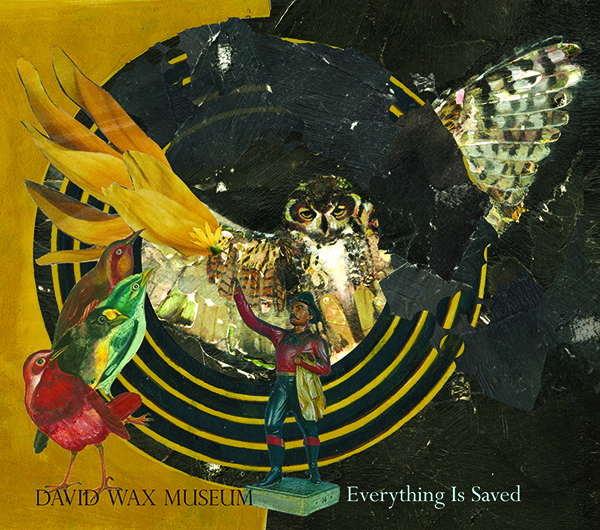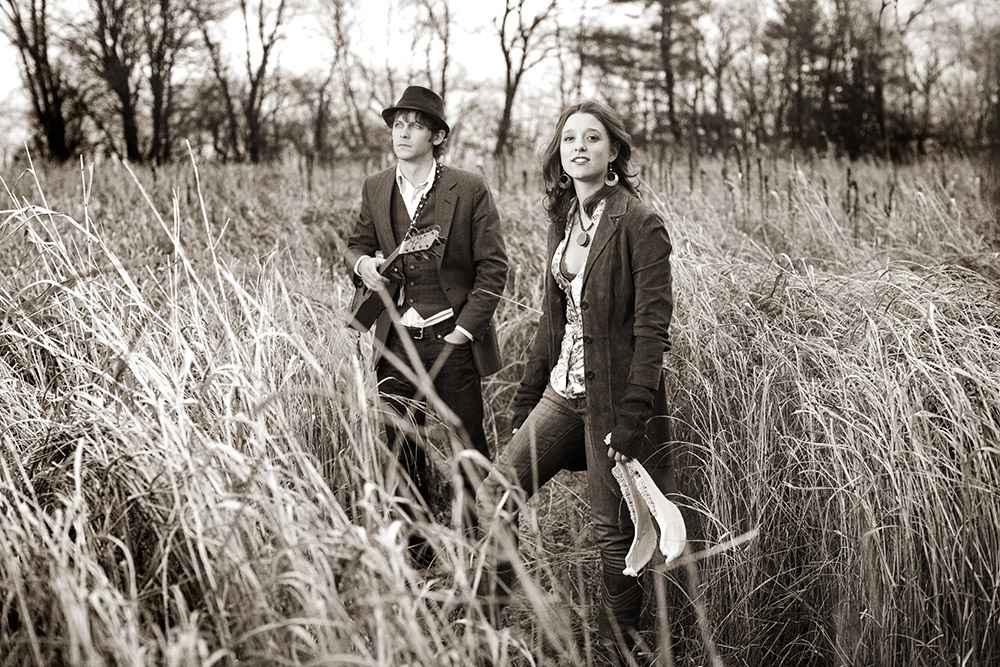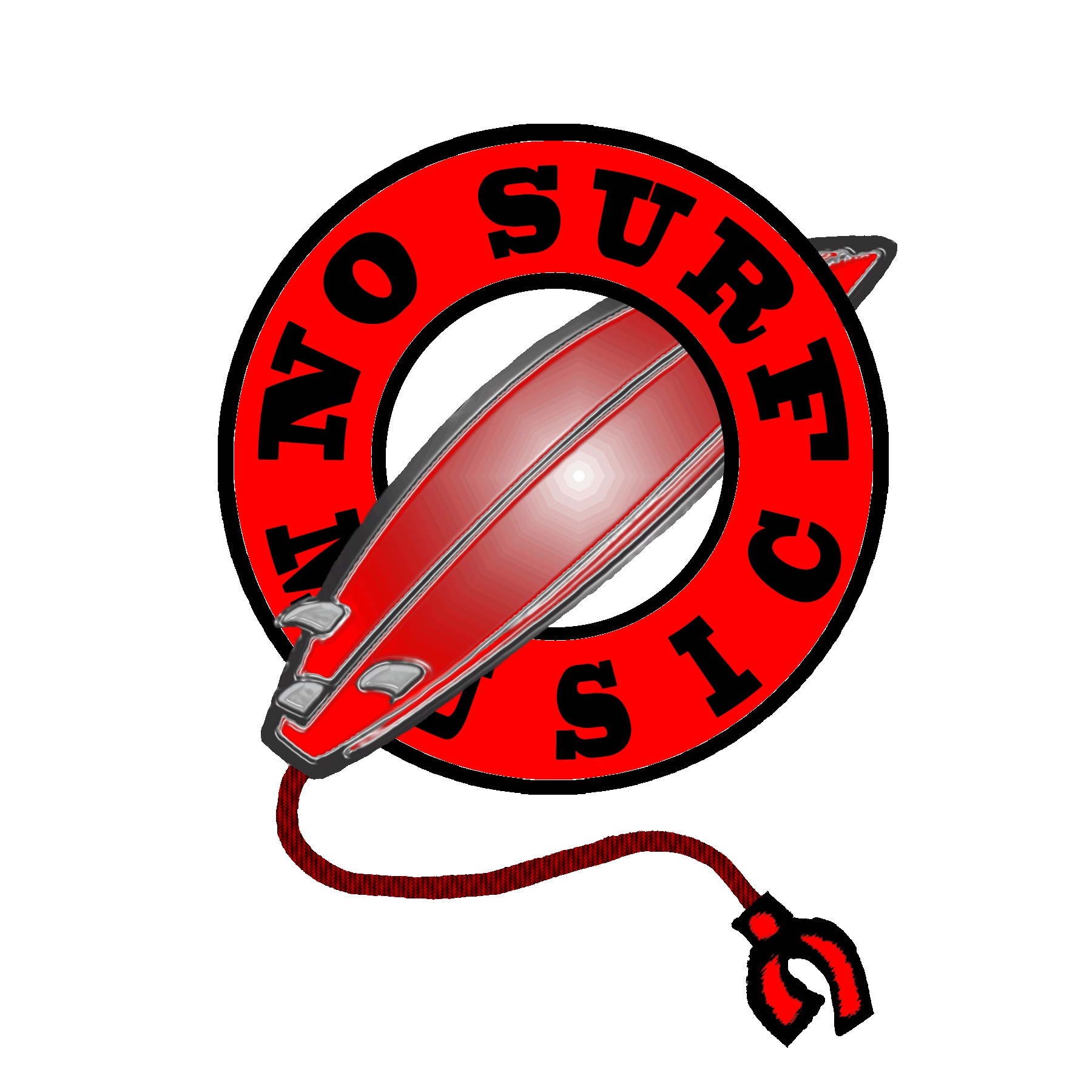
The Lowdown:
May 18, 2011
David Wax Museum: Everything Is Saved
by Jason D. 'Diesel' Hamad
David Wax Museum: Suz Slezak (l) and David Wax (r). Open up the high-res and take a look at the necklace on that girl. Almost as beautiful as she is. Photo by Erik Jacobs, Anthem Multimedia.
David Wax Museum may be the most innovative, exciting act in American music today. They are quirky, energetic, creative and forceful. And they are like nothing anyone has ever heard before. Their unique blend of influences—one part Ozark-root Midwestern folk, one part Mexican traditional, one part indie rock—gives them a sound unlike anyone else. The fusion, which they call Mexo-Americana, is magical.
The core of the band is its namesake, guitar player and singer David Wax, along with fiddler and singer Suz Slezak (who sometimes jokingly refers to herself as Suz Museum). They occasionally include more players, especially when close to their Boston home, but on most road trips are accompanied only by David’s cousin Jordan Wax, who adds accordion and very unique vocal flourishes. In addition to these more familiar instruments, the band’s Mexican influence is reflected in the prominent inclusion of several musical apparati rare in the U.S.: David on the jarana—a stringed instrument with percussive undertones that looks like a guitar and a ukulele had a hot, forbidden liaison and produced a freaky mulatto bastard—and Suz rocking out on the quijada—a traditional South and Central American instrument of Afro-Peruvian origin that is made from the jawbone of a donkey and is alternately scraped with a stick, producing a washboard effect, or struck, giving a literally jaw-rattling percussive kick.
With all of these quirks the band sounds like a mish-mashed disaster waiting to happen, but it comes together perfectly, in no small part due to Wax’s talent as a writer and musical arranger. He brings it all together in a way that makes one think that all of his influences were married from the first, instead of being a singular amalgamation. His strummed strings are lively and entertaining and his vocals are bright and expressive. For her part, Suz is full of life, her fiddle playing spot-on, her vocals beautiful and cutting, and the sheer joy she gets out of going to town on the quijada evident in every rap of the bone.
Seen live they are one of the most entertaining acts on the road today, but their studio work is just as strong. Everything Is Saved, the band’s third album, builds upon the strong work of Carpenter Bird with even more lively, charged compositions highlighting the band’s disparate influences and unique character. It is the most fun you can have with a little round piece of plastic, even on a frisbee golf course.
The best song on the album is probably “Yes, Maria, Yes,” which has been a staple in their live shows for some time. It features high-energy jarana strumming with quijada accents, counterpoint percussion and a lively accordion base. About that rare commitaphobic girl, it is filled with entertaining lines like
You spread your kisses out
Just like a blanket.
Your mouth is a water fountain.
Tell me who will wedding-cake it?
The video, seen here, demonstrates both David and Suz's absolutely irrepressible personalities, as well as an apparently infectious Mexo-American neopeasant fashion sense (do those girls really all shop at the same place?). It also perfectly captures the bouyant spirit of the song.
The highlight of the track may actually be Jordan Wax’s backup vocals, where he responds to David’s calls of:
Yes, Maria, yes.
No, Maria, no.
Reminiscent of old-time recordings before the era of overproduction, they are flourishes that work particularly well live as he leans back under the weight of his squeezebox and just lets rip.
Contending for the top spot is “Unfruitful.” The chorus is cerainly memorable:
David and Suz in an appropriately rural setting. And Suz said, "With the jawbone of an ass--heaps on heaps--with the jaw of an ass have I slain a thousand songs." Diesel Judges 15:16. Photo by Erik Jacobs, Anthem Multimedia.
Tunnels in the same, tunnels in the same
Like two worms we have opened
Tunnels in the same, tunnels in the same
Tunnels in the same apple.
It is taken from a poem by Gonzalo Millán, translated from Spanish by the ever-industrious Wax, while the verses are his own originals. The craziest love song you have ever heard (nothin’ says sexy like a worm), it has a darker, more orchestral sound, with a bowed upright bass providing the undertones. David and Suz’s singing intertwines rather than harmonizes, meeting the song’s annelidic metaphor halfway. In between the rough-hewn vocals are dissonant breaks, with Suz’s string work almost screaming overtop. It’s capped off in a chanting chorus at the end, which comes at great effect as David finally concludes “Our parallel searching has been without fruit until now.”
Another highlight is “The Least I Can Do.” The most soulful song on the album and perhaps its best lyrical composition, its base is a piano and Suz’s sad, lingering fiddle. It even features a bit of blues guitar. Like several other songs on the album, its theme centers on preserving relationships even as life moves on around them and it is reminiscent in parts of John Lennon’s “In My Life.” As Wax sings it:
I’m not trying to get away from anything or anyone.
I’m not trying to get away from you.
At least that’s what I tell myself.
It’s the least I can do.”
Other strong tracks include “Born With a Broken Heart,” the album's first single and a lively tune that starts very simply, with just strummed jarana and clapping hands, but which builds as it goes, adding more percussion, accordion, and finally horns. A song equally about love and fate (o resistance to it), it includes a number of great lines, including:
There are men who will stand accused
But they won’t be told the why.
They were strong so where beaten down
But the stars look gold through blackened eyes.
Again, the accompanying video is boisterous and light, a fine reflection of both the upbeat song and the personality of its performers. Come on, just look at those smiles. Aren't they adorable?
“That’s Not True” is a sedate, full sounding “don’t leave me” song featuring perfect vocal accents delivered by Suz. With a little more of an alt country feel than the other tracks, it builds to a vocally resonant peak adorned by horns, before cutting back to the naked, intertwined voices of David and Suz singing:
Soon you will see your mistake.
You can turn around; it’s not too late.
But that’s not true, and we both know it.
That’s not true.
(Props to Mr. Wax for the correct usage of a semicolon in the liner notes.)
“Night Was a Car” is a depressively themed relationship song with expectations of loss and an undertone of inadequacy. It does have its lively moments and several well-penned lines, including:
You wear a dress.
I am hoping that is all.
I promise not to be sad
When I see it fall.
“Look What You’ve Done to Me” is a slow ballad, dreamy and haunting with alternately crescendoing and decrescendoing waves during the vocal breaks. “Chuchumbe” is a lively clap-dance with traditional lyrics that forces even anti-dance partisans like myself to at least move their feet begrudgingly. It is followed by “Staggering and All,” a crazy and dissonant break with lyrics in Spanish, making it impossible for me to analyze them since I’m as gringo as it gets. However, I’m willing to bet it’s about drinking in Mexico. The final track, “Wait For Me,” is sparse and dependent on David’s soulful vocal delivery and Suz’s well-placed harmonies. An expansion on the themes in “The Least I Can Do,” it provides the album title in its final verse, which reads:
David Wax Museum with the tools of their trade. These two are going to be making great music for a long, LONG time. And we're gonna love every minute of it. Photo by Erik Jacobs, Anthem Multimedia.
I will return
From roads unpaved.
Time’s an archive.
Everything is saved
If you will wait for me.
The only song that doesn’t really work is “Lavender Street,” a slow piano ballad and “after you left me song” that seems somewhat out of place because of both its pace and instrumentation. It’s not necessarily a bad tune—in fact in a vacuum it’s fairly compelling—but it feels like it breaks up the flow of the album as a whole. Still, that whole is so well constructed that this interlude is soon forgotten as the work transitions into its second half.
On their recent tour with Old 97’s, Rhett Miller often said in his introduction that David Wax Museum was the only band he was absolutely sure would be around in ten years. I’m a betting man, and I’ll take them to cover the spread. Given David’s innate creativity and the undeniable musical chemistry between him and Suz, it’s not just evident that they have the potential to produce music of this caliber for a long time to come, but that there is room to expand into even more uncharted territory as they progress. Maybe everything is saved in that great music archive in the sky, but it’s time to get into David Wax Museum now. If you don’t, you’re missing out on some of the best music Americana has to offer.
| mp3 | cd |
|---|---|








